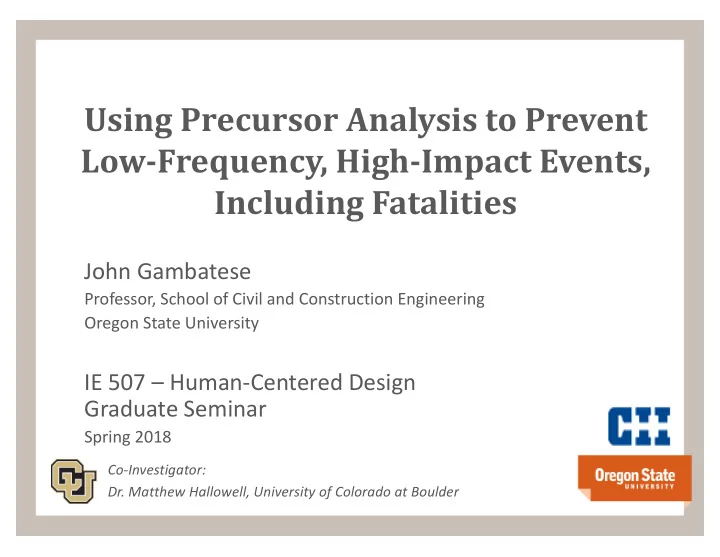

Using Precursor Analysis to Prevent Low-Frequency, High-Impact Events, Including Fatalities John Gambatese Professor, School of Civil and Construction Engineering Oregon State University IE 507 – Human-Centered Design Graduate Seminar Spring 2018 Co-Investigator: Dr. Matthew Hallowell, University of Colorado at Boulder
Why do accidents (still) occur? Source: CII, EM160-21, 2006
Do we know when an accident will occur?
Everyday Life Question: What do you think about when deciding whether to cross a street?
Risk and Reward – Survey Question • How often do you knowingly take a calculated risk even though it is against your training/work safety plan? Number of Responses (n = 150)
CII RT-321 • Using Precursor Analysis to Prevent Low Frequency/High- Impact Events (including fatalities) Dillon Alexander, John Hogan , SNC Lavalin University of Colorado at Boulder Anthony Littlefair , Enbridge Pipelines John Barry , SABIC Innovative Plastics Donna Parry , Procter and Gamble Matthew Bedrich , Shell Gregg Slintak , Jim Duncan , Jacobs Consolidated Edison Co. of New York Shane Farrah , JV Driver Irvin Tyler , Shell John Gambatese , Shawn Xu , Conoco Philips Oregon State University Rick Zellen , Zurich Larry Green , British Petroleum Matthew Hallowell , University of Colorado at Boulder
CII RT-321: Key Definitions Serious injury or fatality (SIF) event: An event that results in or has the potential to result in a fatality or life-altering injury or illnesses. HILF = high impact, low frequency event Precursor*: Reasonably detectable event, condition, or action that serves as a warning sign of an event, i.e., an anomaly *Different than a leading indicator
When should we use precursor analysis? High energy? High Risk SIF Precursors Outcome Situations
Does energy magnitude predict injury severity?
Precursor Analysis Process Is this a Are Should “high precursors the work energy” are proceed? situation? present?
Validate with Experiment to Identify Objective Multiple Test Precursors Statistics Groups Precursors NIOSH Fatality Reports Assessment and Work-Safe from Control BC Research Evaluations Reports Team (FACE) List of Factors Investigation • X Form • X • ????????? • X • ????????? • X • ????????? • X • ????????? Team reviews cases and • X produces list of factors; plus additional factors added from outside experts
Validate with Experiment to Identify Objective Multiple Test Precursors Statistics Groups Precursors High- High- Fatal or Energy energy Disabling Success near miss RATIO: (3) (1) (1) Use precursor investigation form to collect LEADING data for three types of cases
Validate with Experiment to Identify Objective Multiple Test Precursors Statistics Groups Precursors Case Case Case Case Case 3 1 2 4 5 Team predicts Academics manage the process Conduct experiment round
Validate with Experiment to Identify Objective Multiple Test Precursors Statistics Groups Precursors Round 1 3/5 ( 60% ) Near Success Success Success Fatal Miss Round 2 5/5 ( 100% ) Success Success Success HILF HILF Round 3 4/5 ( 80% ) HILF Success HILF HILF Success Round 4 4/4 ( 100% ) HILF Success HILF Success Results from research team trials
Validate with Experiment to Identify Objective Multiple Test Precursors Statistics Groups Precursors Typical Professionals Inexperienced Students Demographic Information Demographic Information # of Participants: 13 # of Participants: 10 Median Age: 53 Median Age: 29 Median Years of Experience: 2 Median Years of Experience: 20 Repeat experiment with diverse groups of people
Validate with Experiment to Identify Objective Multiple Test Precursors Statistics Groups Precursors Principal Generalized Components Linear Analysis Modeling (PCA) Groups like Creates an equation precursors that predicts the Simple data together probability of HILF structure based on precursor Reduces the presence number of variables Find an equation for the probability of an event
Validate with Experiment to Identify Objective Multiple Test Precursors Statistics Groups Precursors 𝑸𝒔𝒑𝒄𝒃𝒄𝒋𝒎𝒋𝒖𝒛 𝒇 (.𝟐0𝟏.𝟑𝟏∗𝒀 𝟐 0𝟏.𝟔𝟕∗𝒀 𝟑 0𝟏.𝟓𝟕∗𝒀 𝟒 0𝟏.𝟑𝟓∗𝒀 𝟓 ) = 𝒇 (.𝟐0𝟏.𝟑𝟏∗𝒀 𝟐 0𝟏.𝟔𝟕∗𝒀 𝟑 0𝟏.𝟓𝟕∗𝒀 𝟒 0𝟏.𝟑𝟓∗𝒀 𝟓 ) + 𝟐 Reduce complexity for ease of use
Validate with Experiment to Identify Objective Multiple Test Precursors Statistics Groups Precursors Regression Precursor Precursor Regression Model Assessment Assessment Case # Model Skill Probability Rubric Score Rubric Skill 22 73.3% Correct 7.5 Correct 20 54.3% Correct 5 Correct 29 62.4% Correct 6 Correct 27 36.3% Correct 2 Correct 21 58.1% Correct 5 Correct 23 76.3% Correct 8 Correct 24 71.6% Correct 8 Correct 25 56.1% Correct 4.5 Correct 26 78.4% Correct 8.5 Correct 28 65.5% Correct 6 Correct
Predicting with the Precursor Analysis Scorecard 1 2 3 Step 1: Enter presence Step 2: Multiply each of each factor: factor by the weight 0 à ‘Not Present’ ½ à ‘Partially Present’ Step 3: Sum the weighted score 1 à ‘Present’ Step 4: Total exceeds 4? HILF event is more likely than not if total exceeds 4 4
Let’s give it a try. 1. Watch video of construction site interview 2. Complete the Precursor Analysis Scorecard Precursor analysis example case: https://www.youtube.com/watch?v=5dz5AE32_gc
The actual outcome? Potentially fatal, near miss.
Using Precursor Analysis to Prevent Low- Frequency, High-Impact Events, Including Fatalities • Thank you for your interest! • Questions? Comments? • For more information: john.gambatese@oregonstate.edu
Recommend
More recommend